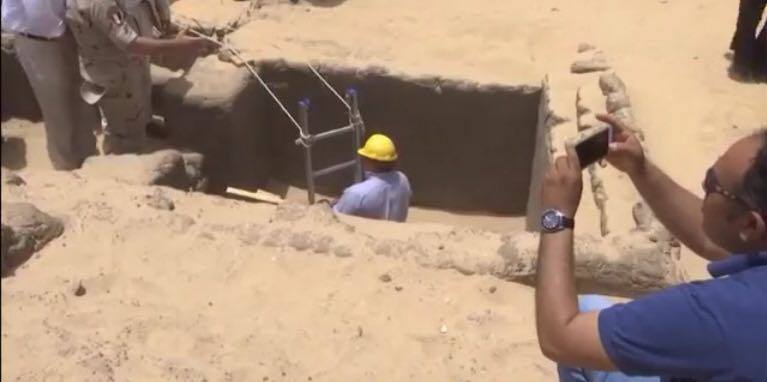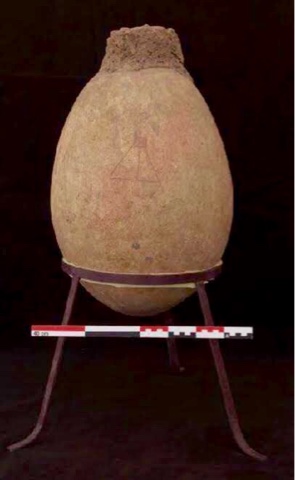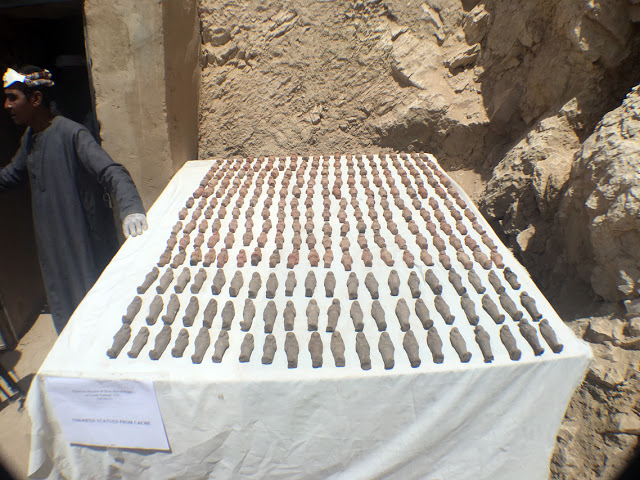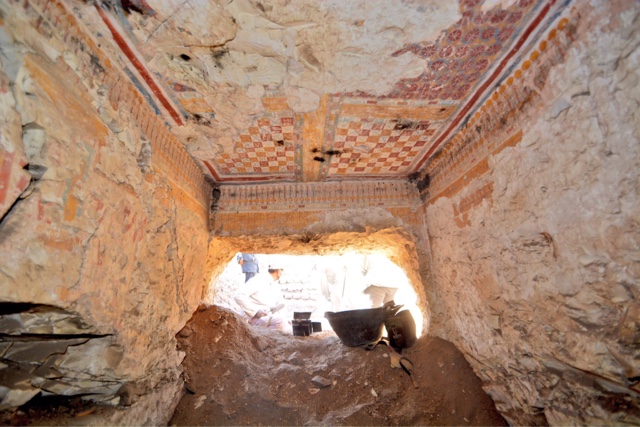new discoveries
- Marian A.Ebrahim
- Dec 9, 2017
- 9 min read
Dec. 2017
Egyptologiest discovered several intact child burials as well as crypts and chambers for adults in the 18th Dynasty Necropolis at Gebel el-Silsila in the Aswan region.
The best-preserved child burials include: 1) An eroded wooden sarcophagus/coffin, partially sealed with mud, containing inhumation of a child (ST63), c. 6-9 years, oriented with head in the east, facing north. Poorly preserved coffin, heavily eroded by annual flooding, salt, and destroyed by beetles.
The grave contained several burial goods, including 10 ceramic items (intact beer jars, wine vessels, plates, and bowls), bronze bracelets, a bronze razor, four scarabs attached to the child’s left wrist, and a nefer-amulet found in the chest-area (moved from its original location by beetles).
2) A rock cut crypt containing young child (2-3 years), wrapped in linen and surrounded by organic material (possibly wooden coffin) destroyed by termites, covered with poorly preserved, crumbled sandstone lid, once sealed with plaster. Head in the south, facing west. Preliminary osteological studies show no obvious cause of death. No associated burial goods.
3) Inhumation of a child, c. 5-8 years, oriented with head in the east, unknown facial direction due to later disturbance of the head, possibly caused when burying the child of ST63. Body wrapped in linen and laid on reed matting. Burial goods included three scarabs, one of which contained a royal name of Thutmosid period, and a single ceramic vessel not in its original location.
4) Inhumation of child c-5-8 years, oriented with head to the north, facing east. Buried without any obvious care in quarried area, and covered with quarry spoil. No immediate relation with surrounding tombs. Several intriguing pathological indications of sickness. Further studies required. In addition to the intact child burials, the team has discovered several new crypts and burial chambers, mainly looted during or since antiquity.
The archaeological material includes bones, ceramic vessels, jewellery, textile, ‘plaster’, and wood. The intact child burials – some unique and others first of their kind at Gebel el-Silsila with their burial goods in situ, adds important insights into the local and contemporaneous funerary customs, pathological information (general health and injuries of the entombed) and add clues into the social and economic organisation of the site during the Thutmosid period, supporting the theory of individuals and entire families involved with quarry work states assistant director John Ward.
Dec. 2017
Two ancient Egyptian New Kingdom-era tombs opened at Luxor necropolis
Two tombs of unidentified officials dated to Egypt’s New Kingdom era have been opened at Luxor’s Draa Abul-Naglaa necropolis years after they were initially discovered by German archaeologist Frederica Kampp in the 1990s.
The opening of the tombs was announced at an international conference
The first tomb, named “Kampp 161,” was never excavated, while excavation work on the second, “Kampp 150,” was undertaken by archaeologist Kampp short of entering the tomb itself. Most of the items discovered in Kampala 161 are fragments of wooden coffins. The most notable discoveries are a large wooden mask that was originally a part of a coffin, a small painted wooden mask, a fragment of a gilded wooden mask in poor condition, four legs of wooden chairs that were among the deceased’s funerary equipment, as well as the lower part of a wooden Osirian shaped coffin decorated with a scene of goddess Isis lifting up her hands.
the tomb belongs to a person named Djehuty Mes, as this name is engraved on one of the walls. The second possibility is that the owner could be the scribe “Maati,” as his name and the name of his wife “Mehi” are inscribed on 50 funerary cones found in the tomb’s rectangular chamber.
The tomb has only one inscription on one of its northern pillars. It shows a scene with a seated man offering food to four oxen, with the first kneeling in front of the man, who is giving it herbs. The scene also depicts five people making funerary furniture.
The entrance of the long hall is inscribed with hieroglyphic text with the name of “Djehuty Mes.” The ceiling of the chamber is inscribed with hieroglyphic inscriptions and the cartouche of King Thutmose I. The objects uncovered inside include 100 funerary cones, painted wooden masks, a collection of 450 statues carved in different materials such as clay, wood and faience, and a small box in the shape of a wooden coffin with a lid.
Also found was a collection of clay vessels of different shapes and sizes as well as a mummy wrapped in linen with its hands on its chest in the Osirian form.
Oct. 2017
Wooden head of a queen
A French- Swiss team working in the area of Sakkara necropolis found a 4000 years old head of the queen Ankhnespepy close to the remains of her pyramid . The head is from wood with wooden earring.
Oct. 2017
largest-ever discovered obelisk fragment from Egypt’s Old Kingdom

“A Swiss-French archaeological mission at the Saqqara necropolis, directed by Professor Philippe Collombert from the University of Geneva, has unearthed the upper part of an Old Kingdom obelisk that belonged to Queen Ankhnespepy II, the mother of King Pepy II (6th Dynasty, Old Kingdom, around 2350 BC).
Collombert said that the part of the obelisk that was unearthed is carved in red granite and is 2.5 metres tall; the largest fragment of an obelisk from the Old Kingdom yet discovered.
“We can estimate that the full size of the obelisk was around five metres when it was intact,” he said. Mostafa Waziri, secretary-general of the Supreme Council of Antiquities, told Ahram Online that the artefact was found at the eastern side of the queen’s pyramid and funerary complex, which confirms that it was removed from its original location at the entrance of her funerary temple. “Queens of the 6th dynasty usually had two small obelisks at the entrance to their funerary temple, but this obelisk was found a little far from the entrance of the complex of Ankhnespepy II,” Waziri pointed out, suggesting it may have been dragged away by stonecutters from a later period. Most of the necropolis was used as a quarry during the New Kingdom and Late Period. Waziri said that the obelisk also bears an inscription on one side, with what seems to be the beginning of the titles and the name of Queen Ankhnespepy II. “She is probably the first queen to have pyramid texts inscribed into her pyramid,” Waziri said. He explains that before her, such inscriptions were only carved in kings’ pyramids. After Ankhnespepy II, some wives of King Pepy II did the same. Collombert says that at the top of the obelisk, there is a small deflection that indicates that the pyramidion (the tip) was covered with metal slabs, probably of copper or golden foil, to make the obelisk glint in the sun. The main goal of the mission, which was established in 1963 by Jean-Philippe Lauer and Jean Leclant, is to study the pyramid texts of the Old Kingdom. Since 1987, the mission has also been excavating the necropolis of the queens buried in pyramids around the pyramid of Pepy I. This year, the mission is continuing work on the funerary complex of Queen Ankhnespepy II, the most important queen of the 6th dynasty. Ankhnespepy II was married to Pepy I, and upon his death, she married Pepy I’s son, Merenre, from her sister Ankhnespepy I. Ankhnespepy II gave birth to the future King Pepy II. Merenre died when Pepy II was around six years old. Ankhnespepy II then became regent, and the effective ruler of the country, but did not go as far as to become pharaoh, as Hatshepsut did later on. “This is probably why her pyramid is the biggest of the necropolis after the pyramid of the king himself,” he said” – via Ahram Online.
Aug.2017
Three Ptolemaic tombs found in Al-Kamin Al-Sahrawi


“During excavation work carried out at Al-Kamin Al-Sahrawi area, south east of Samalout Town in Al-Menia Governorate,an Egyptian archaeological mission from the Ministry of Antiquities discovered three Ptolemaic tombs.
excavators have unearthed a collection of sarcophagi of different shapes and sizes as well as clay fragments that date the tombs between the 27th Dynasty and the Greaco-Roman era.
“A fact suggests that the area was a great cemetery along a long span of time,” , along the previous excavation work the mission succeeded to uncover about 20 tombs designed in Catacombs architecture, which was wide spread during the 27th dynasty and the Greaco-Roman time.
the three newly discovered tombs have a different architecture design than the previously discovered ones. The first tomb is composed of a perpendicular burial shaft engraved in the rock and leads to a burial chamber containing four sarcophagi with anthropoid lids. Nine burial holes were also uncovered.

The second tomb consists of a perpendicular burial shaft and two burial chambers. the first chamber is located to the north, where remains of two sarcophagi are found suggesting that it was the burial of two people. A collection of 6 holes for burial were also found among them one was the burial of a small child.
“This was the first time to find a burial of a child in kamin Al-Sahrawi site,” Al-Bakry said adding that the second room is located at the end of the shaft and does not contain anything except of remains of a wooden coffin.
Excavation Works at the third tomb has not finished yet.

studies carried out on bones found show that the bones are for men, women and children of different ages, a fact affirms that these tombs was part of a large cemetery for a large city and not a military garrisons as some suggest.
The first excavation mission started in 2015 when the mission unearthed a collection of five sarcophagi of different shapes and sizes as well as remains of a wooden sarcophagus. The second session starts in October 2016 where five tombs were uncovered.
Four of them have similar interior design while the fifth consists of a burial shaft.
may 2017
17 mummies have been found in EL -Minia
Egyptian Egyptologists have found 17 mummies in catacombs in EL- Minia town south of Cairo in Tuna El Gabal province with some artifacts in a deep burial shaft .
may 2107
Jars filled with mummification materials rediscovered in Luxor
The Spanish Egyptian archaeological mission rediscovered 56 jars filled with materials used in mummification process date back to the Middle Kingdom 12 dynasty.Actually they were discovered in 1922 by an American Egyptologist and placed in a room neglected and buried again by the time
These will help us to know some secrets about the mummification process performed in the Middle Kingdom.
Apr. 2017
- new tomb in the west bank of luxor
The Egyptian archaeological team found a tomb of a nobleman called Userhat in the West Bank of Luxor A well preserved coffin, a collection of ushabti statues, wooden masks and a handle of a sarcophagus lid was unearthed .
Mar. 2017
an intact 4000 years old tomb in Aswan
The Spanish Archaeological Mission in Qubbet el-Hawa, West Aswan, has discovered an intact burial chamber. The discovered burial belongs to the brother of one of the most important governors of the 12th Dynasty (middle Kingdom), Sarenput 2nd
the tomb still has all the funerary goods, which consist of pottery, two cedar coffins (outer and inner) and a set of wooden models, which represents funerary boats and scenes of the daily life. a mummy was also discovered but still under study. It is covered with a poly chrome car-tonnage with a beautiful mask and collars in good condition of preservation.
- Mar. 2017
2 statues in old Heliopolis
The Egyptian- Germane mission unearthed 2 statues in old Heliopolis One of them for Seti 2nd measures about 80 cm high
The other is for Psmatik 2nd , the part found shows that the statute measures about 8 mts. Heigh , The statues were submerged a meter deep in underground water.
They will be taken to the new museum in Cairo.
- Jan. 2017
- New tomb in the West Bank of Luxor
A Japanese mission were actually working in another tomb and then found a big carved hole in it's northern wall after crawling through it they found the new tomb of Khonso , a royal scribe .
It consists of an entrance then a hall and a burial chamber . with beautiful scenes on it's walls .
- Nov. 2016
Paintings of boats at Abydos
Near the tomb of Senusert 3rd , In A 3,800 year old building researchers found More than 120 images of boats also include gazelle, cattle, flowers .
In the same area they found 145 pottery jars which would have been used to store liquids
- Nov. 2016
new tomb in the West Bank of Luxor
Adjacent to Thutmosis 3rd temple a new tomb has been found by a spanish mission . the Tomb is of the servant of the royal house .
The coffin inside is really well preserved with the mummy inside .
- march 2016
Prehistoric paintings in Aswan
Prehistoric paintings were found in the West Bank of Aswan close to the tomb of the nobles
The paintings are of wild animals gazales , cows , giraffes, ostriches .
- 6 rock-cut statutes discovered in Gebal el Silsila
The mission of Lund university, directed by Dr. Maria Nilsson , discovered 6 rock-cut statutes in Gebal el Silsila , north of aswan .
They are located in 2 shrines
the shrine No. 30 has 2 of them for the owner and his wife he is represented dead with crossed arms, she puts her left arm on his shoulder
The other 4 statues in shrine No. 31 are for the owner of the shrine Neferkhewe and his family Wife, son and daughter .

Two Australian researchers have managed to translate an ancient Egyptian handbook that belonged to a ritual practitioner an incredible 1,300 years ago. The "Handbook of Ritual Power" contains a number of spells and invocations, ranging from love spells, spells to exorcise evil spirits and cure ailments, as well as the ability to summon deities.
The book is written in Coptic,, and is 20 pages long. According to the researchers, the beginning of the codex consists of a series of invocations, "words of power." It then leads you to a variety of spells for curing disease and being successful in life.
One spell is supposed to allow you to control another person. In order to do so, the practitioner must chant magic words over two nails, and then drive the nails into the doorpost of the person you want to control - one nail on the left, and one on the right.





























































































































































Comments